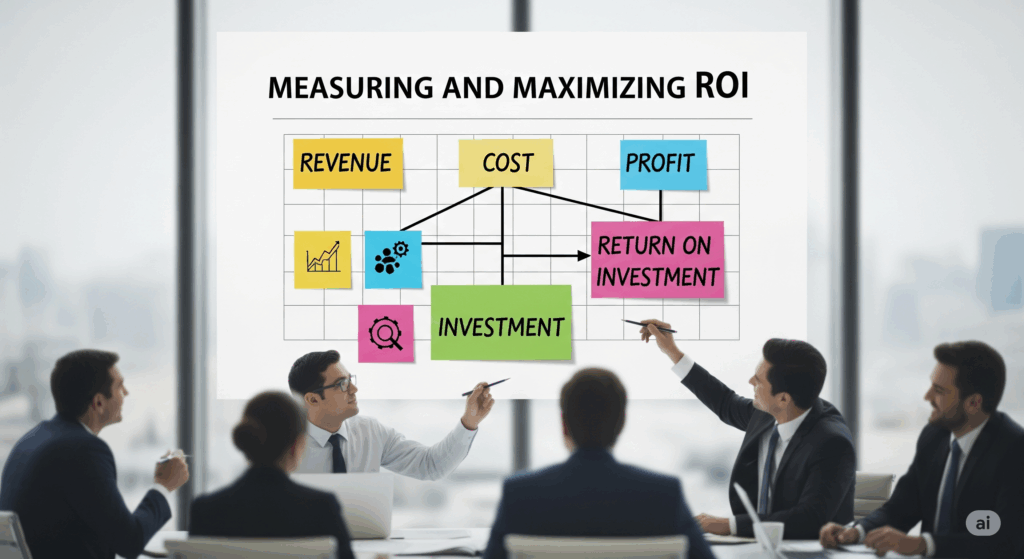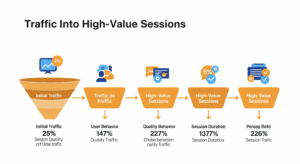Ever poured your heart and soul into creating fantastic content, only to be met with the nagging question, “But what’s the return on all that effort?” If you’re a marketer, you’ve likely been there. Proving the return on investment (ROI) of your content marketing efforts isn’t just a good idea; it’s essential for securing budgets, optimizing strategies, and truly understanding your content’s impact.
This isn’t just another theoretical guide. Consider this your comprehensive blueprint, a practical roadmap, and even a glimpse into real-world successes, showing you exactly how to measure and maximize your content’s undeniable value.
The ROI Riddle: Why Content Marketers Struggle to Prove Impact
It’s a common dilemma. Unlike some direct response campaigns, content marketing often plays a long game. It builds trust, nurtures leads, and establishes authority over time. This makes direct attribution tricky. How do you quantify the value of a blog post that informed a prospect months before they converted? Or a video that boosted your brand’s perception?
The challenge lies in connecting content activities to tangible business outcomes. But here’s the good news: it’s entirely possible. And once you crack the code, your content marketing becomes a strategic powerhouse.
Laying the Foundation: Defining Your Content Marketing KPIs
Before you can measure anything, you need to know what you’re measuring. Key Performance Indicators (KPIs) are your North Star, guiding you toward relevant data. Don’t just pick vanity metrics; focus on KPIs that align directly with your business goals.
Here are some essential content marketing KPIs to consider:
- Engagement Metrics:
- Page Views/Unique Visitors: How many people are seeing your content?
- Time on Page: Are they sticking around to consume it? (A strong indicator of interest!)
- Bounce Rate: Are people quickly leaving? (High bounce rates might signal irrelevant content or poor user experience.)
- Social Shares & Comments: Is your content resonating enough for people to share and discuss?
- Lead Generation & Conversion Metrics:
- Lead Magnet Downloads/Sign-ups: How many leads is your content generating directly?
- Form Submissions: Are people taking action after consuming your content?
- Click-Through Rate (CTR): Are your calls to action (CTAs) effective?
- Conversion Rate: What percentage of content consumers are converting into leads or customers?
- Revenue & Business Impact Metrics:
- Marketing Qualified Leads (MQLs) & Sales Qualified Leads (SQLs): How many quality leads is your content nurturing through the funnel?
- Sales Attributed to Content: This is the ultimate goal! How much revenue can you directly link to your content efforts?
- Customer Lifetime Value (CLTV): Does content contribute to more loyal, higher-value customers?
- Reduced Customer Acquisition Cost (CAC): Can content help lower the cost of acquiring new customers?
The Attribution Puzzle: Giving Credit Where Credit’s Due
Understanding which touchpoints contributed to a conversion is critical. This is where attribution models come into play. There isn’t a one-size-fits-all solution, but exploring these common models can help you allocate credit effectively:
- First-Touch Attribution: Gives 100% credit to the first piece of content a customer interacted with. Great for understanding initial awareness.
- Last-Touch Attribution: Assigns all credit to the final piece of content before conversion. Useful for understanding what seals the deal.
- Linear Attribution: Distributes credit equally across all content touchpoints in the customer journey. Offers a balanced view.
- Time Decay Attribution: Gives more credit to touchpoints closer to the conversion. Recognizes the increasing influence of recent interactions.
- W-Shaped Attribution: Attributes 30% to the first touch, 30% to the lead creation touch, 30% to the opportunity creation touch, and the remaining 10% to other touches. Ideal for longer sales cycles.
The best approach often involves using a combination of models or a multi-touch attribution model that reflects your unique customer journey.
Beyond the Numbers: Using Analytics to Track Content Performance
Your analytics platforms are your best friends here. Tools like Google Analytics, your CRM, and marketing automation platforms provide a wealth of data.
Here’s how to leverage them:
- Set Up Goals and Events: Configure your analytics to track specific actions users take after engaging with your content (e.g., downloading an e-book, filling out a contact form, watching a specific video).
- Content Grouping: Organize your content by topic, type (blog posts, videos, infographics), or funnel stage. This helps you understand which types of content perform best for different objectives.
- Funnel Visualization: Map out the customer journey and identify where users drop off. This helps you pinpoint content gaps or areas for improvement.
- Heatmaps and Session Recordings: Tools like Hotjar can show you exactly how users interact with your content, revealing what they click, scroll, and ignore. This is invaluable for optimizing content performance.
The Math of Success: Calculating Your Content ROI
Now for the moment of truth: putting a number on your content’s impact. The basic formula for ROI is straightforward:
ROI = CostofContent (RevenuefromContent−CostofContent) × 100%
Let’s break down the components:
- Revenue from Content: This is where your attribution model comes in. You need to assign a monetary value to the leads and sales generated by your content. If a blog post contributed to X number of sales, and your average sale value is Y, you can start to quantify the revenue.
- Cost of Content: Don’t forget anything! This includes:
- Content creation (writer salaries, freelance fees, design, video production)
- Content distribution (paid promotion, social media ads)
- Tools and software (CMS, analytics platforms, SEO tools)
- Time spent by your team (planning, editing, optimizing)
While this formula provides a clear picture, remember that some benefits of content (like brand building and thought leadership) are harder to quantify directly but still contribute to long-term success.
Real Stories, Real Results: Content Marketing Case Studies in Action
Sometimes, seeing is believing. Let’s look at how focused content strategies have translated into measurable business outcomes for others. These aren’t just hypothetical scenarios; they demonstrate the power of a strategic approach.
- Case Study 1: The B2B SaaS Company and the Explainer Video Series
- Challenge: Low conversion rates on product pages.
- Content Strategy: Developed a series of short, engaging explainer videos addressing common pain points and showcasing product features.
- KPIs Tracked: Video completion rates, CTA clicks within videos, demo requests from video viewers, and ultimately, sales pipeline influenced by video.
- Outcome: A 15% increase in demo requests directly attributed to video content, leading to a significant boost in qualified leads and a measurable ROI from the video production investment within six months. The videos also helped reduce the sales cycle length by educating prospects upfront.
- Case Study 2: The E-commerce Brand and the “How-To” Blog Content
- Challenge: Low organic search visibility for specific product categories.
- Content Strategy: Created a comprehensive library of “how-to” blog posts and guides answering common customer questions related to their products. These were optimized for long-tail keywords.
- KPIs Tracked: Organic traffic to blog posts, keyword rankings, lead magnet downloads (e.g., “ultimate buying guides”), and ultimately, direct product sales originating from blog post visitors.
- Outcome: A 200% increase in organic traffic to their blog within a year, ranking for numerous valuable long-tail keywords. This resulted in a 30% increase in direct sales attributed to organic search content, demonstrating a clear content marketing ROI through increased website traffic and conversions.
These examples underscore a crucial point: when you align your content with clear objectives and rigorously track its performance, you can unlock incredible value.
Maximizing Your Content’s Impact: Beyond Measurement
Measurement is just the first step. To truly maximize your content’s impact, you need to act on your insights.
- Content Audits: Regularly review your existing content. What’s performing well? What needs updating? What should be retired? This helps you identify gaps and opportunities.
- A/B Testing: Experiment with different headlines, CTAs, content formats, and even image choices. Small tweaks can lead to significant improvements in performance.
- Repurpose and Re-promote: Don’t let great content gather dust! Turn a blog post into an infographic, a video series into a podcast, or a whitepaper into a series of social media snippets. This extends your content’s reach and gets more mileage out of your efforts.
- Audience-Centricity: Always keep your audience at the forefront. What are their pain points? What questions do they have? Tailor your content to their needs, and it will naturally perform better.
- SEO Best Practices: Naturally integrate LSI keywords and follow SEO best practices to ensure your content is discoverable. This includes optimizing for search intent, using clear headings, and building internal and external links.
The Last Word: Your Content is an Investment, Not an Expense
Proving the ROI of content marketing might seem daunting, but it’s an incredibly rewarding endeavor. By meticulously defining your KPIs, intelligently attributing credit, leveraging your analytics, and continuously optimizing, you transform your content from a perceived cost into a demonstrable, revenue-generating asset.
Your content isn’t just words on a page or pixels on a screen; it’s a powerful tool for building relationships, solving problems, and driving business growth. Start measuring, start optimizing, and start showcasing the incredible impact of your content today. You’ve got this!







